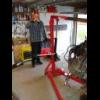How much friction would these generate as they must be a tight fit in the bore or does that rail allow for expansion and contraction..
Hand Rotated Hissing Engine !
Started by
grahama
, Oct 08 2012 03:26 PM
16 replies to this topic
#16

Posted 11 October 2012 - 12:26 PM
#17

Posted 11 October 2012 - 12:37 PM
Thanks for the link Midridge. Interesting. So it's not really a "no gap" ring, it is a multi-piece, labyrinth-like stacked ring.
In an unusual bit of timing, I just this past weekend was discussing with an engine builder acquaintance of mine the effect of ring gap on engine power . I cannot cite the engine builder's source but he mentioned reports discussing how a decrease in engine power was not measurable until the ring gap significantly exceeded the values normally followed in engine building. That is not to say that ring gap does not lead to blow-by and that blow-by is not important. His point was only that gap (and blow-by from it) did not seriously affect engine power until the gap became much greater than what is performed in normal practice.
EDIT: Sonikk, I assume that the rail is sandwiched below the gap in the ring... sort of a second, smaller ring forming a labyrinth as I mentioned above. The ring could not be truely gapless as: a continuous ring would be impossible to install and a continous ring (or one with zero gap) would bind in the bore due to thermal expansion. The only way this could work woud be if that rail was free to move at least under one "end" of the split ring. Their comment about gasses getting behind the rings is not new. I believe that is an old hot-rodder design called a Dykes ring. The idea being that the ring is undercut on one side so on the intake stroke it has little to no drag on the bore but on the compression and power strokes the higher perssures push the ring out firmly against the bore when better sealing is needed.
http://www.mecoa.com...s/ringtypes.htm
In an unusual bit of timing, I just this past weekend was discussing with an engine builder acquaintance of mine the effect of ring gap on engine power . I cannot cite the engine builder's source but he mentioned reports discussing how a decrease in engine power was not measurable until the ring gap significantly exceeded the values normally followed in engine building. That is not to say that ring gap does not lead to blow-by and that blow-by is not important. His point was only that gap (and blow-by from it) did not seriously affect engine power until the gap became much greater than what is performed in normal practice.
EDIT: Sonikk, I assume that the rail is sandwiched below the gap in the ring... sort of a second, smaller ring forming a labyrinth as I mentioned above. The ring could not be truely gapless as: a continuous ring would be impossible to install and a continous ring (or one with zero gap) would bind in the bore due to thermal expansion. The only way this could work woud be if that rail was free to move at least under one "end" of the split ring. Their comment about gasses getting behind the rings is not new. I believe that is an old hot-rodder design called a Dykes ring. The idea being that the ring is undercut on one side so on the intake stroke it has little to no drag on the bore but on the compression and power strokes the higher perssures push the ring out firmly against the bore when better sealing is needed.
http://www.mecoa.com...s/ringtypes.htm
Edited by dklawson, 11 October 2012 - 12:43 PM.
1 user(s) are reading this topic
0 members, 1 guests, 0 anonymous users















